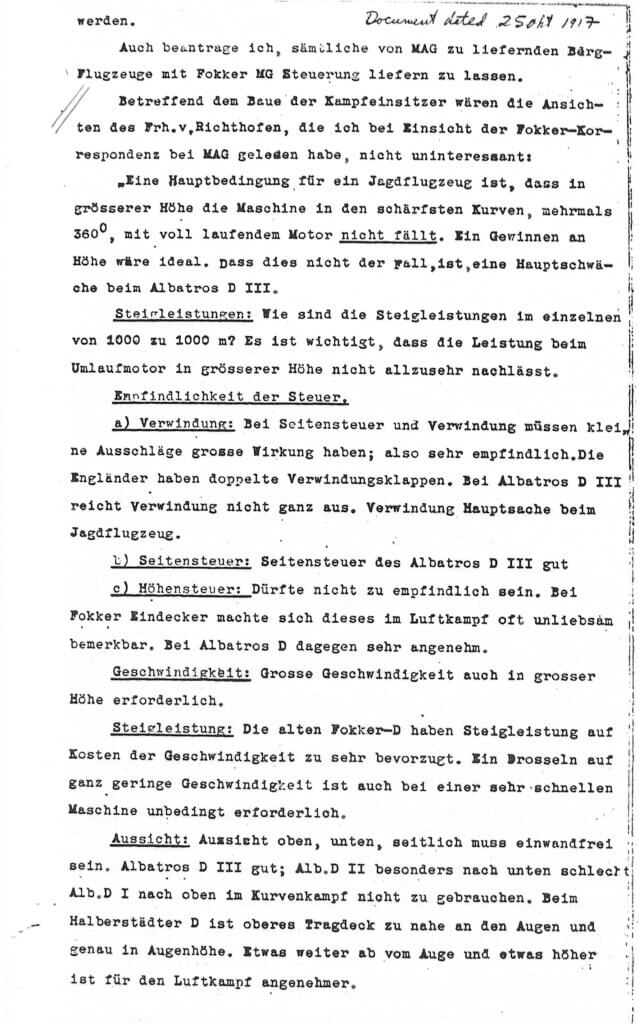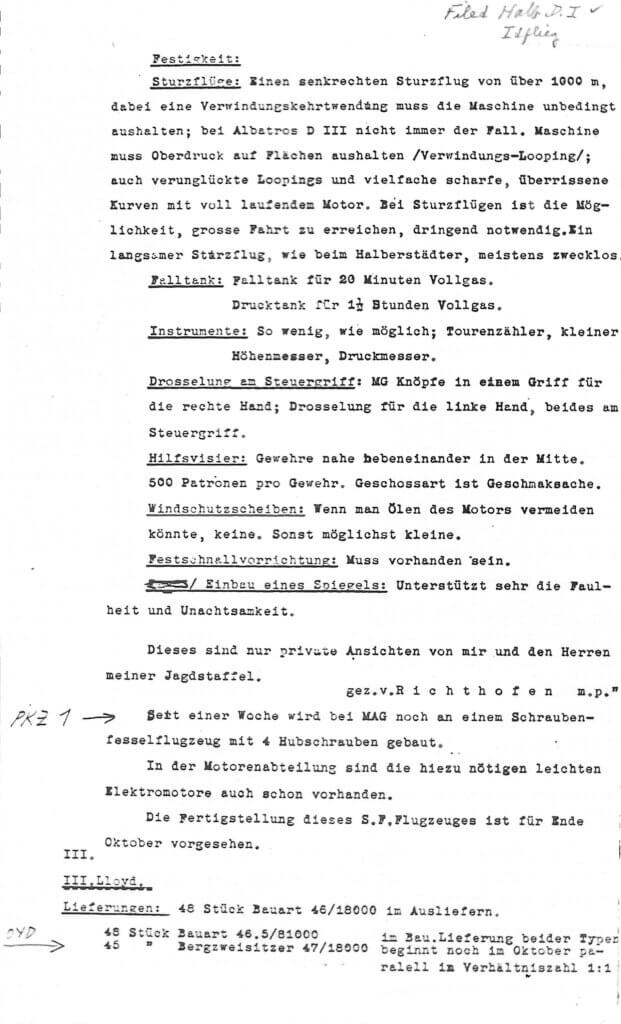MvR’s report to Anthony Fokker
Event ID: 812
Categories:
25 October 1917
Source ID: 71
ISBN: 978-1-964637-05-1
I also request that all salvage aircraft to be delivered by MAG
be supplied with Fokker MG controls.
With regard to the construction of the single-seat fighter, the views of Baron von Richthofen, which I read in the Fokker correspondence at MAG, are not without interest:
“A key requirement for a fighter aircraft is that, at higher altitudes, the aircraft does not fall when performing the sharpest turns, several times 360°, with the engine running at full throttle.
“A key requirement for a fighter aircraft is that, at
high altitudes, the aircraft does not fall when performing the sharpest turns, several
360°, with the engine running at full throttle. Gaining
altitude would be ideal. The fact that this is not the case is a major weakness
of the Albatros D III.
Climbing performance: What is the climbing performance in detail
from 1000 to 1000 m? It is important that the performance of the
rotary engine does not decrease too much at higher altitudes.
Sensitivity of the controls.
a) Twist: With ailerons and twist, small deflections must have a large effect; i.e. very sensitive.
The The
English have double ailerons. On the Albatros D III,
twisting is not quite sufficient. Twisting is essential on a
fighter aircraft.
b) Ailerons: The ailerons on the Albatros D III are good.
c) Elevator: Should not be too sensitive. On the
Fokker monoplane, this often proved to be an unpleasant factor in aerial combat.
On the In the Albatros D, on the other hand, it is very pleasant.
Speed: High speed is also required at high
altitudes.
Climbing performance: The old Fokker Ds favoured climbing performance at
the expense of speed. Throttling down to
very low speed is also essential in a very fast
aircraft.
Visibility: Visibility above, below and to the sides must be perfect.
Albatros D III good; Alb.D II particularly poor below.
A1b.D I useless above in turning combat. In the
Halberstadt D, the upper wing is too close to the eyes and
exactly at eye level. Slightly further away from the eyes and slightly higher
is more comfortable for aerial combat.
Stability:
Dives: The aircraft must be able to withstand a vertical dive of over 1000 m,
including a twisting turn;
this is not always the case with the Albatros D III, the aircraft
must be able to withstand upper pressure on the wings /twisting loop/;
also failed loops and multiple sharp, exaggerated
turns with the engine running at full throttle. During dives, the ability
to reach high speeds is essential. A
slow dive, as with the Halberstädter, is usually pointless.
Drop tank: Drop tank for 20 minutes at full throttle.
Pressurised tank for 1½ hours at full throttle.
Instruments: As few as possible; Rev counter, small
altimeter, pressure gauge.
Throttle on the control stick: MG buttons in one handle for
the right hand; throttle for the left hand, both on the
control stick.
Auxiliary sight: Guns close together in the centre.
500 rounds per gun. The type of ammunition is a matter of taste.
Windscreens: If you could avoid oiling the engine,
none. Otherwise, as small as possible.
Seat belt: Must be present.
Installation of a mirror: Greatly encourages laziness
and carelessness.
These are only my private views and those of the gentlemen
of my hunting squadron,
signed v.Richthofen m.p.”
For a week now, MAG has been working on a screw-driven
fixed-wing aircraft with four propellers.
The engine department already has the necessary lightweight
electric motors.
Completion of this S.F. aircraft is scheduled for the end of
October.
III Lloyd.
Deliveries: 48 units of type 46/18000 in delivery.
48 units of type 46.5/81000 in construction. Delivery of both
45 “mountain two-seaters 47/18900 will begin in October in parallel
at a ratio of 1:1.


Comments (0)